The Infrared Extinction Law in the Ophiuchus Molecular Cloud Based on the UKIDSS and Spitzer c2d Surveys
Abstract
1. Introduction
2. Observations
2.1. The UKIDSS GCS
2.2. Spitzer c2d Project
2.3. Control of the Data Quality
3. Methods and Analysis
3.1. Determination of the Extinction Law
3.2. Non-Linearity of Extinction Coefficients
4. Results and Discussions
4.1. Determination of
4.2. Determination of
4.3. Dependence on Extinction Depth
4.4. Spatial Variations across the Cloud
5. Conclusions
- We obtained the UKIDSS NIR color-excess ratios for the entire Ophiuchus cloud to be approximately , corresponding to and when assuming a power-law NIR extinction law. The relative extinctions, compared to the K band, were also calculated for other wavelength bands, and the measurement results are summarized in Table 2. Additionally, we observed that the derived MIR extinction law in the ∼3–8 m range exhibits a flat behavior and closely resembles the WD01 model extinction law with = 5.5. In contrast, the NIR extinction law exhibited a steeper slope compared to the extinction law of WD01 = 5.5.
- We examined the variation of the extinction law with increasing extinction depth by analyzing the average extinction laws of four sub-samples classified into different extinction bins: , , , and . Instead of assuming a uniform value of , we calculated the specific for each sub-sample using and then derived for other wavelength bands. Our analysis revealed a noticeable trend of a flatter extinction law from the NIR to MIR bands as the extinction increased. This observed trend is consistent with previous studies conducted by Naoi et al. [41] and Chapman et al. [46].
- We also discussed the spatial variation of the extinction law within the Ophiuchus molecular cloud. Our analysis revealed no significant difference in the MIR extinction law among the four dark clouds, namely L1712, L1689, L1709, and L1688. However, we observed noticeable variations in the extinction law for the regions located outside the dark clouds, specifically L1688N and L1688W. These regions exhibited a lower color-excess ratio in the Spitzer/IRAC bands. These findings provide further support for dust growth in the dense regions of the Ophiuchus cloud.
Author Contributions
Funding
Data Availability Statement
Acknowledgments
Conflicts of Interest
References
- Draine, B.T. Interstellar Dust Grains. Annu. Rev. Astron. Astrophys. 2003, 41, 241–289. [Google Scholar] [CrossRef]
- Zubko, V.; Dwek, E.; Arendt, R.G. Interstellar Dust Models Consistent with Extinction, Emission, and Abundance Constraints. Astrophys. J. Suppl. Ser. 2004, 152, 211–249. [Google Scholar] [CrossRef]
- Compiègne, M.; Verstraete, L.; Jones, A.; Bernard, J.P.; Boulanger, F.; Flagey, N.; Le Bourlot, J.; Paradis, D.; Ysard, N. The global dust SED: Tracing the nature and evolution of dust with DustEM. Astron. Astrophys. 2011, 525, A103. [Google Scholar] [CrossRef]
- Hensley, B.S.; Draine, B.T. Observational Constraints on the Physical Properties of Interstellar Dust in the Post-Planck Era. Astrophys. J. 2021, 906, 73. [Google Scholar] [CrossRef]
- Whittet, D.C.B.; Gerakines, P.A.; Tielens, A.G.G.M.; Adamson, A.J.; Boogert, A.C.A.; Chiar, J.E.; de Graauw, T.; Ehrenfreund, P.; Prusti, T.; Schutte, W.A.; et al. Detection of Abundant CO2 Ice in the Quiescent Dark Cloud Medium toward Elias 16. Astrophys. J. Lett. 1998, 498, L159–L163. [Google Scholar] [CrossRef]
- Ossenkopf, V.; Henning, T. Dust opacities for protostellar cores. Astron. Astrophys. 1994, 291, 943–959. [Google Scholar]
- Ormel, C.W.; Min, M.; Tielens, A.G.G.M.; Dominik, C.; Paszun, D. Dust coagulation and fragmentation in molecular clouds. II. The opacity of the dust aggregate size distribution. Astron. Astrophys. 2011, 532, A43. [Google Scholar] [CrossRef]
- Lada, C.J.; Lada, E.A.; Clemens, D.P.; Bally, J. Dust Extinction and Molecular Gas in the Dark Cloud IC 5146. Astrophys. J. 1994, 429, 694. [Google Scholar] [CrossRef]
- Lombardi, M.; Alves, J. Mapping the interstellar dust with near-infrared observations: An optimized multi-band technique. Astron. Astrophys. 2001, 377, 1023–1034. [Google Scholar] [CrossRef]
- Alves, J.F.; Lada, C.J.; Lada, E.A. Internal structure of a cold dark molecular cloud inferred from the extinction of background starlight. Nature 2001, 409, 159–161. [Google Scholar] [CrossRef]
- Fitzpatrick, E.L. Correcting for the Effects of Interstellar Extinction. Publ. Astron. Soc. Pac. 1999, 111, 63–75. [Google Scholar] [CrossRef]
- Cardelli, J.A.; Clayton, G.C.; Mathis, J.S. The relationship between infrared, optical, and ultraviolet extinction. Astrophys. J. 1989, 345, 245–256. [Google Scholar] [CrossRef]
- Wang, S.; Jiang, B.W. Universality of the Near-infrared Extinction Law Based on the APOGEE Survey. Astrophys. J. Lett. 2014, 788, L12. [Google Scholar] [CrossRef]
- Schultheis, M.; Kordopatis, G.; Recio-Blanco, A.; de Laverny, P.; Hill, V.; Gilmore, G.; Alfaro, E.J.; Costado, M.T.; Bensby, T.; Damiani, F.; et al. The Gaia-ESO Survey: Tracing interstellar extinction. Astron. Astrophys. 2015, 577, A77. [Google Scholar] [CrossRef]
- Matsunaga, N.; Bono, G.; Chen, X.; de Grijs, R.; Inno, L.; Nishiyama, S. Impact of Distance Determinations on Galactic Structure. I. Young and Intermediate-Age Tracers. Space Sci. Rev. 2018, 214, 74. [Google Scholar] [CrossRef]
- Román-Zúñiga, C.G.; Lada, C.J.; Muench, A.; Alves, J.F. The Infrared Extinction Law at Extreme Depth in a Dark Cloud Core. Astrophys. J. 2007, 664, 357–362. [Google Scholar] [CrossRef]
- Gao, J.; Jiang, B.W.; Li, A. Mid-Infrared Extinction and its Variation with Galactic Longitude. Astrophys. J. 2009, 707, 89–102. [Google Scholar] [CrossRef]
- Weingartner, J.C.; Draine, B.T. Dust Grain-Size Distributions and Extinction in the Milky Way, Large Magellanic Cloud, and Small Magellanic Cloud. Astrophys. J. 2001, 548, 296–309. [Google Scholar] [CrossRef]
- Cambrésy, L.; Rho, J.; Marshall, D.J.; Reach, W.T. Variation of the extinction law in the Trifid nebula. Astron. Astrophys. 2011, 527, A141. [Google Scholar] [CrossRef]
- Wang, S.; Li, A.; Jiang, B.W. Very Large Interstellar Grains as Evidenced by the Mid-infrared Extinction. Astrophys. J. 2015, 811, 38. [Google Scholar] [CrossRef]
- Wang, S.; Li, A.; Jiang, B.W. The interstellar oxygen crisis, or where have all the oxygen atoms gone? Mon. Not. R. Astron. Soc. 2015, 454, 569–575. [Google Scholar] [CrossRef]
- Ascenso, J.; Lada, C.J.; Alves, J.; Román-Zúñiga, C.G.; Lombardi, M. The mid-infrared extinction law in the darkest cores of the Pipe Nebula. Astron. Astrophys. 2013, 549, A135. [Google Scholar] [CrossRef][Green Version]
- Mamajek, E.E. On the distance to the Ophiuchus star-forming region. Astron. Nachrichten 2008, 329, 10. [Google Scholar] [CrossRef]
- Casewell, S.; Hambly, N. The UKIDSS Galactic Clusters Survey. In Proceedings of the Thirty Years of Astronomical Discovery with UKIRT, Edinburgh, UK, 14–16 September 2009; Adamson, A., Davies, J., Robson, I., Eds.; Springer: Dordrecht, The Netherlands, 2013; Volume 37, p. 291. [Google Scholar] [CrossRef]
- Lawrence, A.; Warren, S.J.; Almaini, O.; Edge, A.C.; Hambly, N.C.; Jameson, R.F.; Lucas, P.; Casali, M.; Adamson, A.; Dye, S.; et al. The UKIRT Infrared Deep Sky Survey (UKIDSS). Mon. Not. R. Astron. Soc. 2007, 379, 1599–1617. [Google Scholar] [CrossRef]
- Hewett, P.C.; Warren, S.J.; Leggett, S.K.; Hodgkin, S.T. The UKIRT Infrared Deep Sky Survey ZY JHK photometric system: Passbands and synthetic colours. Mon. Not. R. Astron. Soc. 2006, 367, 454–468. [Google Scholar] [CrossRef]
- Hodgkin, S.T.; Irwin, M.J.; Hewett, P.C.; Warren, S.J. The UKIRT wide field camera ZYJHK photometric system: Calibration from 2MASS. Mon. Not. R. Astron. Soc. 2009, 394, 675–692. [Google Scholar] [CrossRef]
- Evans, N.J., II; Allen, L.E.; Blake, G.A.; Boogert, A.C.A.; Bourke, T.; Harvey, P.M.; Kessler, J.E.; Koerner, D.W.; Lee, C.W.; Mundy, L.G.; et al. From Molecular Cores to Planet-forming Disks: An SIRTF Legacy Program. Publ. Astron. Soc. Pac. 2003, 115, 965–980. [Google Scholar] [CrossRef]
- Juvela, M.; Montillaud, J. Allsky NICER and NICEST extinction maps based on the 2MASS near-infrared survey. Astron. Astrophys. 2016, 585, A38. [Google Scholar] [CrossRef]
- Lombardi, M.; Lada, C.J.; Alves, J. 2MASS wide field extinction maps. II. The Ophiuchus and the Lupus cloud complexes. Astron. Astrophys. 2008, 489, 143–156. [Google Scholar] [CrossRef]
- Taylor, M.B. TOPCAT & STIL: Starlink Table/VOTable Processing Software. In Proceedings of the Astronomical Data Analysis Software and Systems XIV, Pasadena, CA, USA, 24–27 October 2004; Shopbell, P., Britton, M., Ebert, R., Eds.; Astronomical Society of the Pacific Conference Series; Astronomical Society of the Pacific: San Francisco, CA, USA, 2005; Volume 347, p. 29. [Google Scholar]
- Grasser, N.; Ratzenböck, S.; Alves, J.; Großschedl, J.; Meingast, S.; Zucker, C.; Hacar, A.; Lada, C.; Goodman, A.; Lombardi, M.; et al. The ρ Ophiuchi region revisited with Gaia EDR3. Two young populations, new members, and old impostors. Astron. Astrophys. 2021, 652, A2. [Google Scholar] [CrossRef]
- Indebetouw, R.; Mathis, J.S.; Babler, B.L.; Meade, M.R.; Watson, C.; Whitney, B.A.; Wolff, M.J.; Wolfire, M.G.; Cohen, M.; Bania, T.M.; et al. The Wavelength Dependence of Interstellar Extinction from 1.25 to 8.0 μm Using GLIMPSE Data. Astrophys. J. 2005, 619, 931–938. [Google Scholar] [CrossRef]
- Stead, J.J.; Hoare, M.G. The slope of the near-infrared extinction law. Mon. Not. R. Astron. Soc. 2009, 400, 731–742. [Google Scholar] [CrossRef]
- Wang, S.; Chen, X. The Optical to Mid-infrared Extinction Law Based on the APOGEE, Gaia DR2, Pan-STARRS1, SDSS, APASS, 2MASS, and WISE Surveys. Astrophys. J. 2019, 877, 116. [Google Scholar] [CrossRef]
- Meingast, S.; Alves, J.; Lombardi, M. VISION—Vienna Survey in Orion. II. Infrared extinction in Orion A. Astron. Astrophys. 2018, 614, A65. [Google Scholar] [CrossRef]
- Castelli, F.; Kurucz, R.L. New Grids of ATLAS9 Model Atmospheres. In Proceedings of the Modelling of Stellar Atmospheres, Uppsala, Sweden, 17–21 June 2002; Piskunov, N., Weiss, W.W., Gray, D.F., Eds.; Astronomical Society of the Pacific Conference Series; Astronomical Society of the Pacific: San Francisco, CA, USA, 2003; Volume 210, p. A20. [Google Scholar] [CrossRef]
- Sanders, J.L.; Smith, L.; González-Fernández, C.; Lucas, P.; Minniti, D. The extinction law in the inner 3 × 3 deg2 of the Milky Way and the red clump absolute magnitude in the inner bar-bulge. Mon. Not. R. Astron. Soc. 2022, 514, 2407–2424. [Google Scholar] [CrossRef]
- Harris, D.H.; Woolf, N.J.; Rieke, G.H. Ice mantles and abnormal extinction in the Rho Ophiuchi cloud. Astrophys. J. 1978, 226, 829–838. [Google Scholar] [CrossRef]
- Kenyon, S.J.; Lada, E.A.; Barsony, M. The Near-Infrared Extinction Law and Limits on the Pre-Main-Sequence Population of the rho Ophiuchi Dark Cloud. Astron. J. 1998, 115, 252–262. [Google Scholar] [CrossRef]
- Naoi, T.; Tamura, M.; Nakajima, Y.; Nagata, T.; Suto, H.; Murakawa, K.; Kandori, R.; Sasaki, S.; Baba, D.; Kato, D.; et al. Near-Infrared Extinction Law in the ρ Ophiuchi and Chamaeleon Dark Clouds. Astrophys. J. 2006, 640, 373–382. [Google Scholar] [CrossRef]
- Rieke, G.H.; Lebofsky, M.J. The interstellar extinction law from 1 to 13 microns. Astrophys. J. 1985, 288, 618–621. [Google Scholar] [CrossRef]
- Nishiyama, S.; Tamura, M.; Hatano, H.; Kato, D.; Tanabé, T.; Sugitani, K.; Nagata, T. Interstellar Extinction Law Toward the Galactic Center III: J, H, KS Bands in the 2MASS and the MKO Systems, and 3.6, 4.5, 5.8, 8.0 μm in the Spitzer/IRAC System. Astrophys. J. 2009, 696, 1407–1417. [Google Scholar] [CrossRef]
- Fritz, T.K.; Gillessen, S.; Dodds-Eden, K.; Lutz, D.; Genzel, R.; Raab, W.; Ott, T.; Pfuhl, O.; Eisenhauer, F.; Yusef-Zadeh, F. Line Derived Infrared Extinction toward the Galactic Center. Astrophys. J. 2011, 737, 73. [Google Scholar] [CrossRef]
- Gordon, K.D.; Misselt, K.A.; Bouwman, J.; Clayton, G.C.; Decleir, M.; Hines, D.C.; Pendleton, Y.; Rieke, G.; Smith, J.D.T.; Whittet, D.C.B. Milky Way Mid-Infrared Spitzer Spectroscopic Extinction Curves: Continuum and Silicate Features. Astrophys. J. 2021, 916, 33. [Google Scholar] [CrossRef]
- Chapman, N.L.; Mundy, L.G.; Lai, S.P.; Evans, N.J., II. The Mid-Infrared Extinction Law in the Ophiuchus, Perseus, and Serpens Molecular Clouds. Astrophys. J. 2009, 690, 496–511. [Google Scholar] [CrossRef]
- Flaherty, K.M.; Pipher, J.L.; Megeath, S.T.; Winston, E.M.; Gutermuth, R.A.; Muzerolle, J.; Allen, L.E.; Fazio, G.G. Infrared Extinction toward Nearby Star-forming Regions. Astrophys. J. 2007, 663, 1069–1082. [Google Scholar] [CrossRef]
- Naoi, T.; Tamura, M.; Nagata, T.; Nakajima, Y.; Suto, H.; Murakawa, K.; Kandori, R.; Sasaki, S.; Nishiyama, S.; Oasa, Y.; et al. Near-Infrared Extinction in the Coalsack Globule 2. Astrophys. J. 2007, 658, 1114–1118. [Google Scholar] [CrossRef]
- McClure, M. Observational 5–20 μm Interstellar Extinction Curves Toward Star-Forming Regions Derived From Spitzer IRS Spectra. Astrophys. J. Lett. 2009, 693, L81–L85. [Google Scholar] [CrossRef]
- Xue, M.; Jiang, B.W.; Gao, J.; Liu, J.; Wang, S.; Li, A. A Precise Determination of the Mid-infrared Interstellar Extinction Law Based on the APOGEE Spectroscopic Survey. Astrophys. J. Suppl. Ser. 2016, 224, 23. [Google Scholar] [CrossRef]
- Maíz Apellániz, J.; Pantaleoni González, M.; Barbá, R.H.; García-Lario, P.; Nogueras-Lara, F. Galactic extinction laws—I. A global NIR analysis with 2MASS photometry. Mon. Not. R. Astron. Soc. 2020, 496, 4951–4963. [Google Scholar] [CrossRef]
- Nogueras-Lara, F.; Schödel, R.; Najarro, F.; Gallego-Calvente, A.T.; Gallego-Cano, E.; Shahzamanian, B.; Neumayer, N. Variability of the near-infrared extinction curve towards the Galactic centre. Astron. Astrophys. 2019, 630, L3. [Google Scholar] [CrossRef]
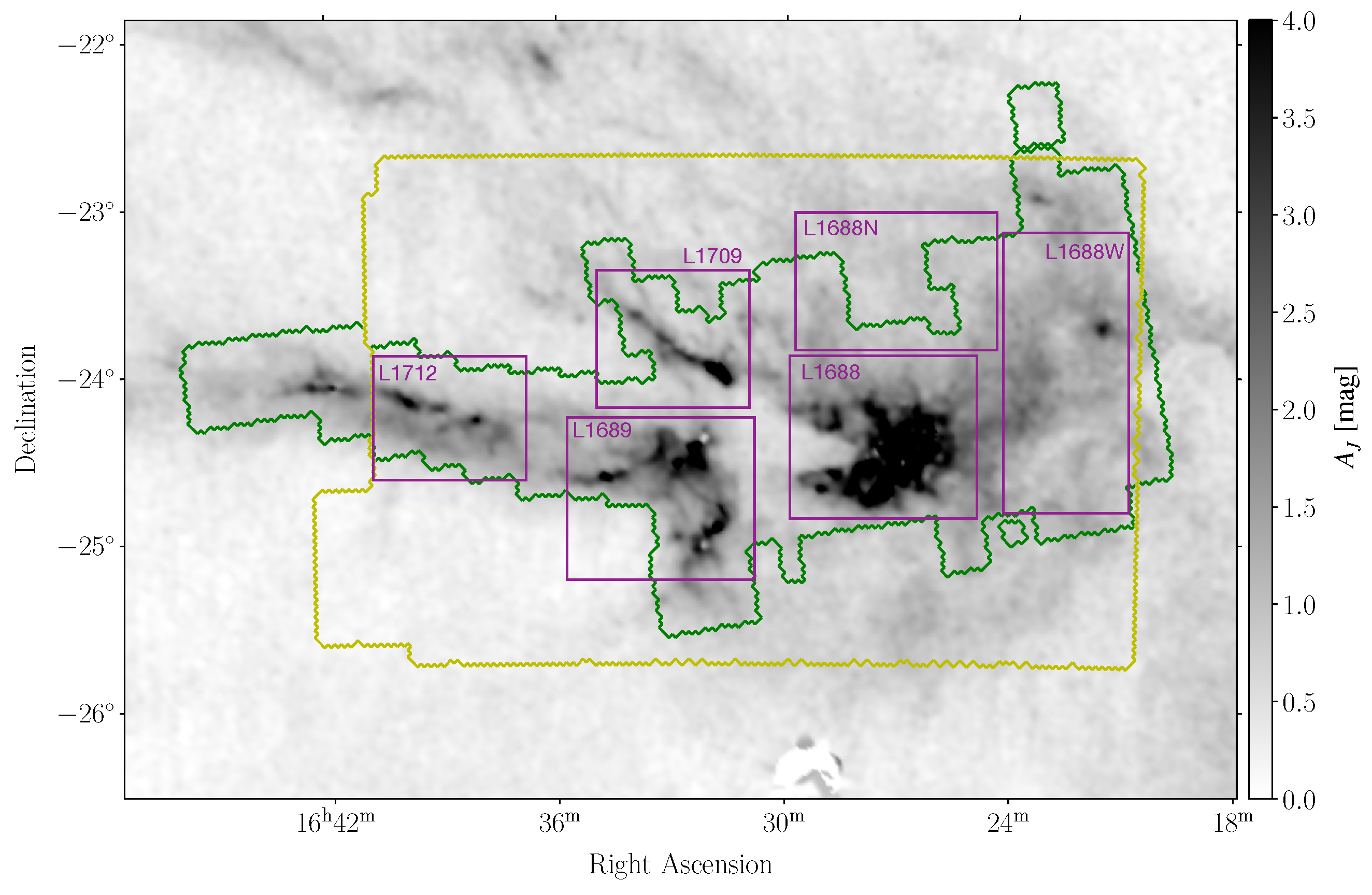

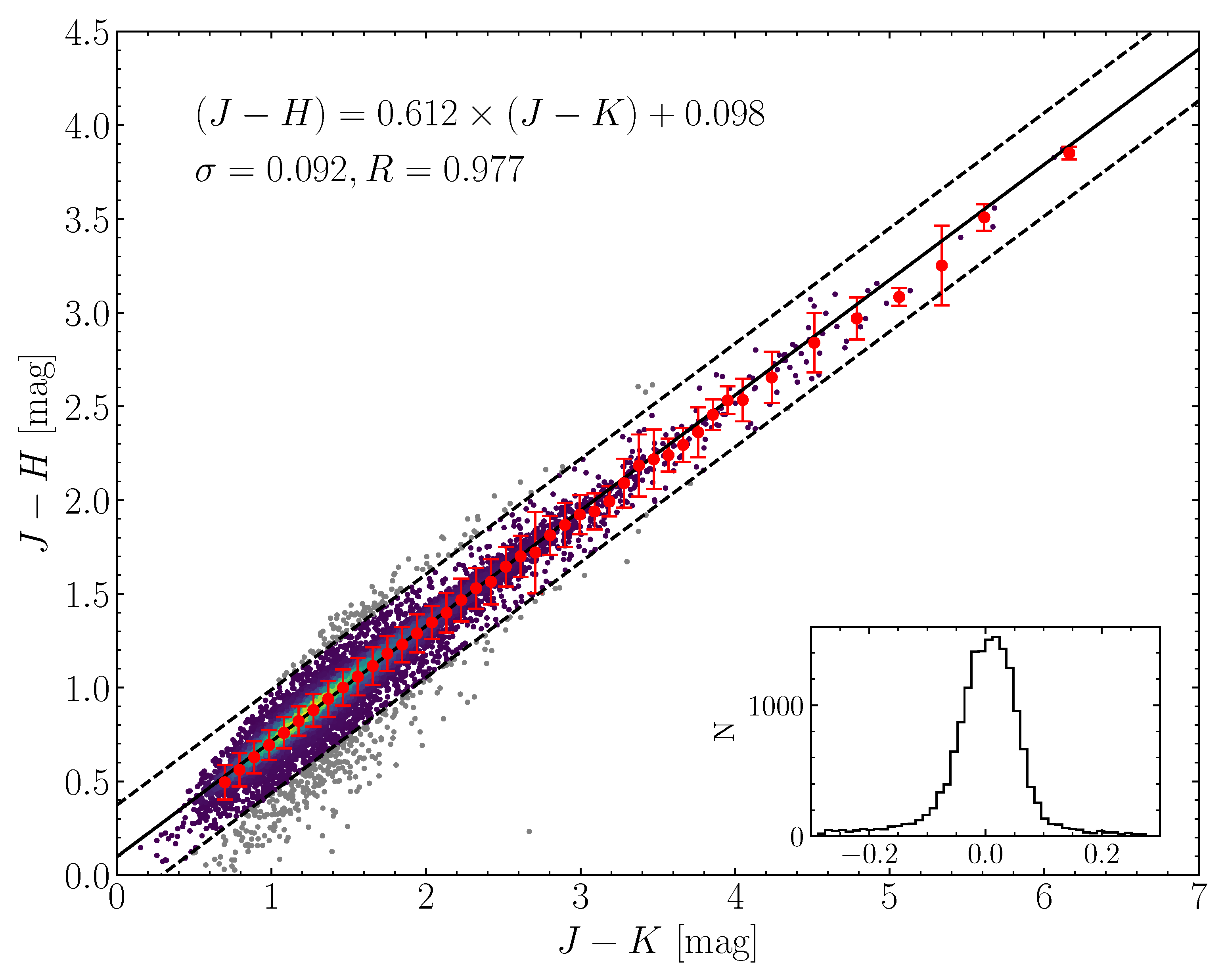
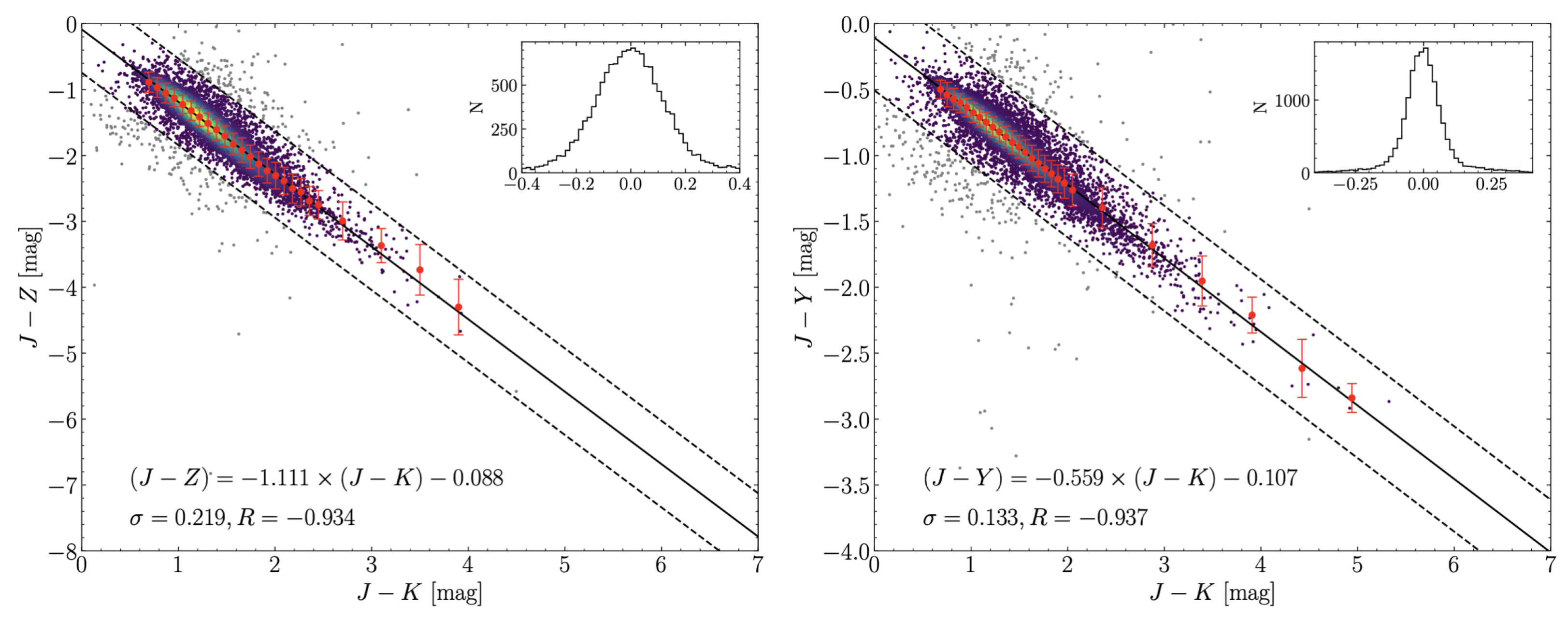
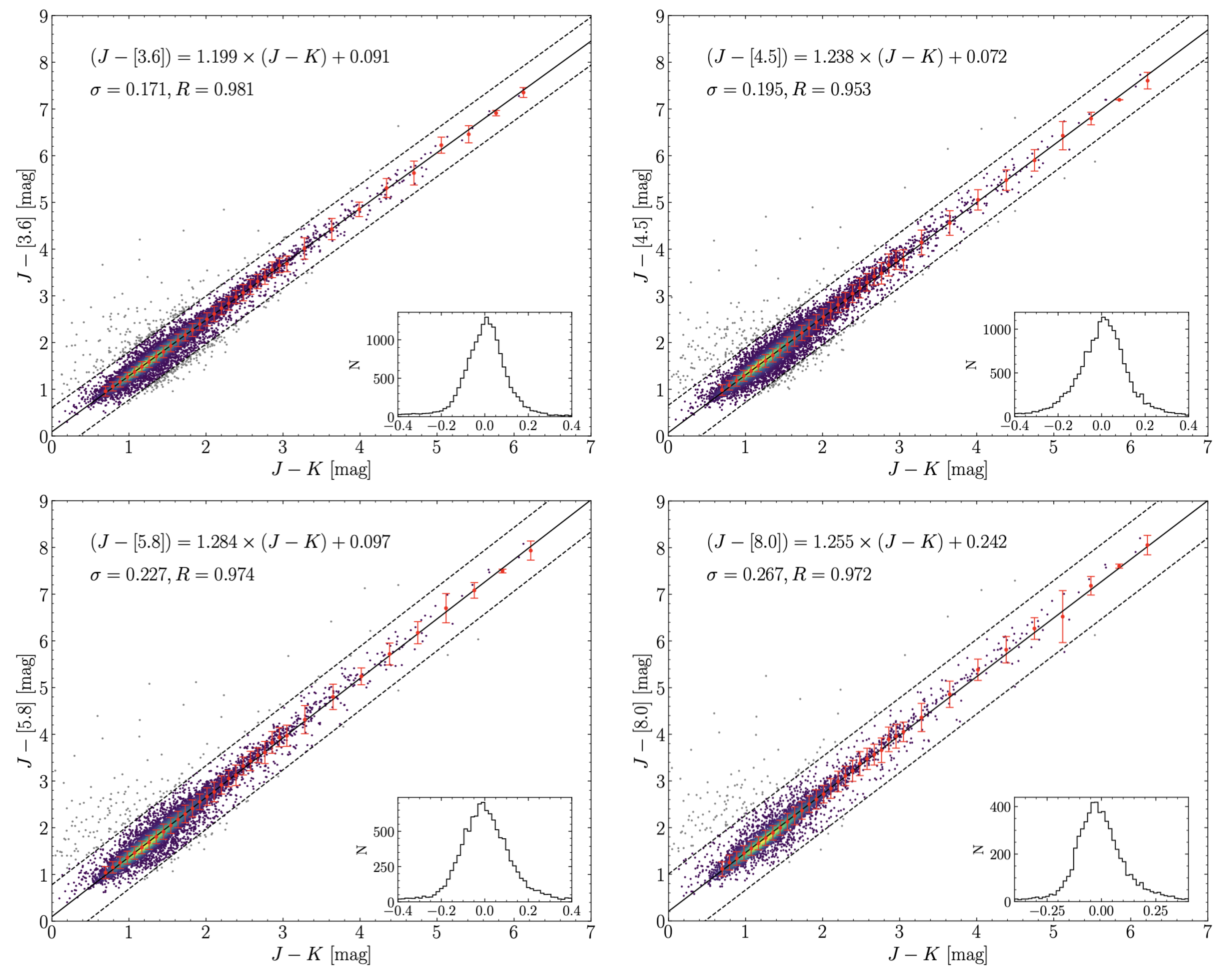
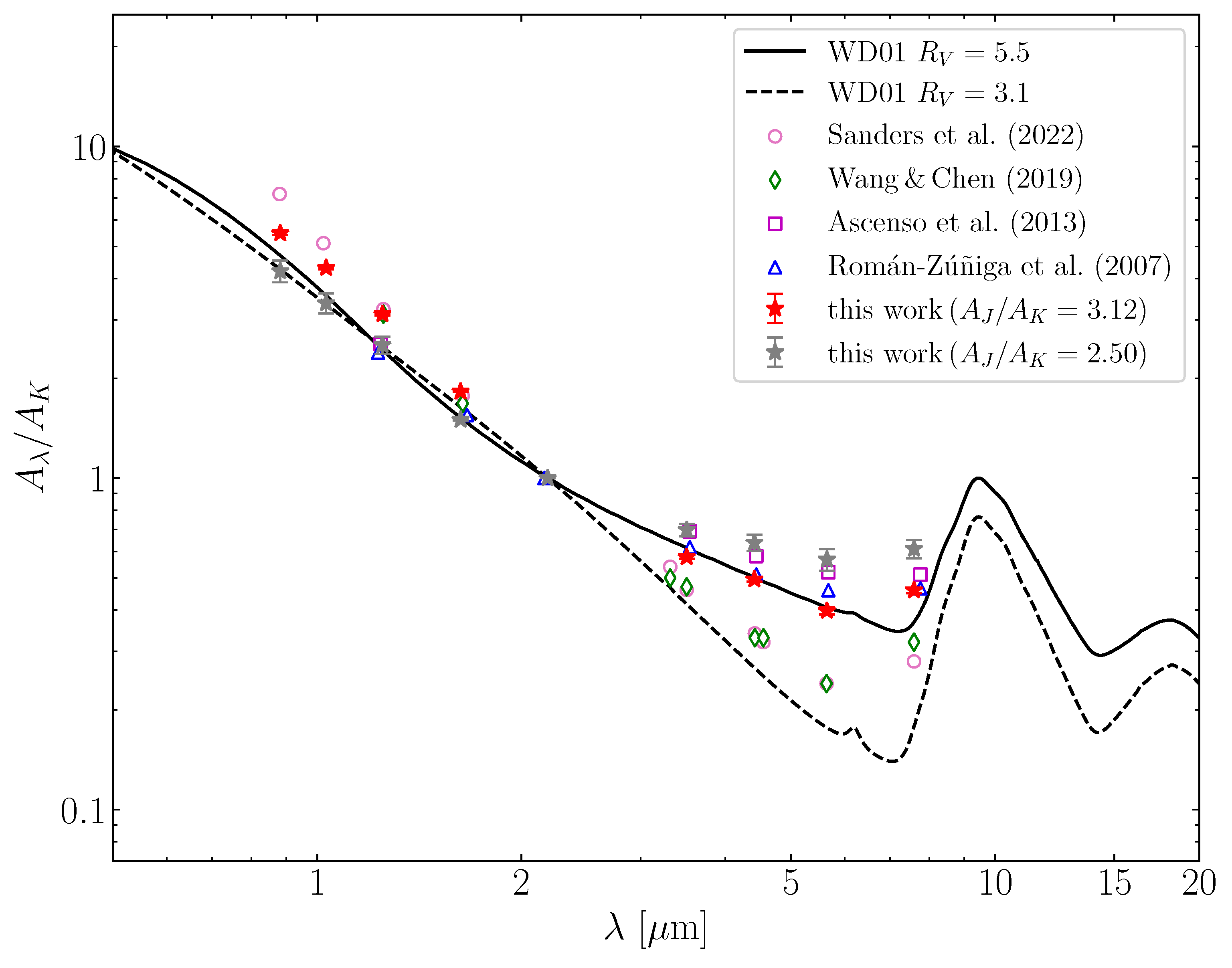
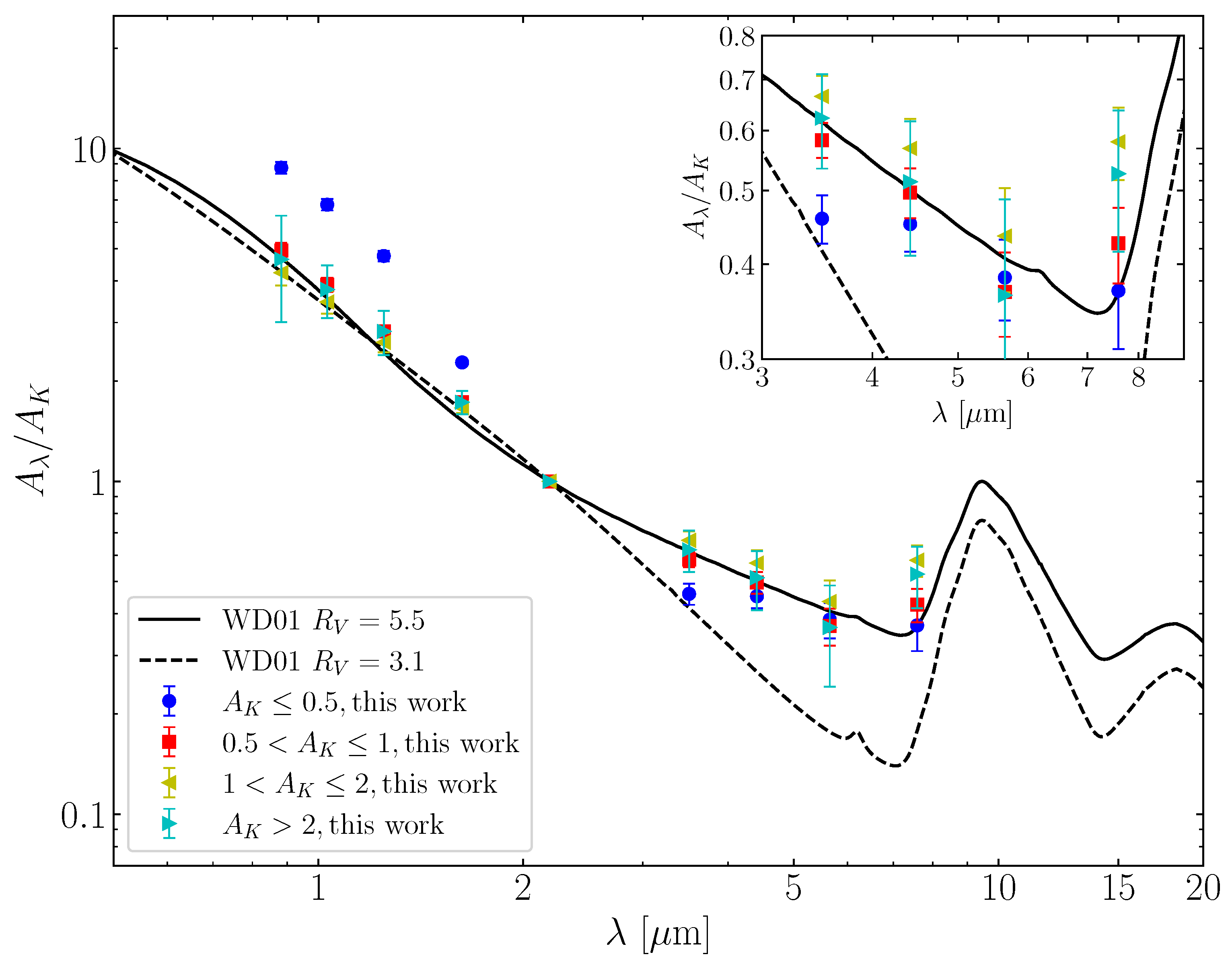

| Band | () | FWHM () | Limits (mag) | Number |
|---|---|---|---|---|
| Z | 0.882 | 0.092 | 20.1 | 15,743 |
| Y | 1.031 | 0.103 | 19.5 | 16,714 |
| J | 1.248 | 0.158 | 19.4 | 18,078 |
| H | 1.627 | 0.295 | 17.8 | 17,494 |
| K | 2.188 | 0.351 | 16.9 | 18,456 |
| 3.508 | 0.743 | 16.6 | 18,601 | |
| 4.414 | 1.010 | 15.9 | 18,610 | |
| 5.648 | 1.391 | 15.3 | 12,104 | |
| 7.592 | 2.831 | 14.8 | 6751 |
| Band | |||
|---|---|---|---|
| () | () | ||
| Z | −1.111 ± 0.003 | 5.475 ± 0.057 | 4.209 ± 0.317 |
| Y | −0.559 ± 0.002 | 4.305 ± 0.042 | 3.370 ± 0.234 |
| H | 0.612 ± 0.001 | 1.824 ± 0.008 | 1.550 ± 0.100 |
| 1.199 ± 0.002 | 0.578 ± 0.007 | 0.698 ± 0.030 | |
| 1.238 ± 0.003 | 0.495 ± 0.008 | 0.639 ± 0.036 | |
| 1.284 ± 0.003 | 0.398 ± 0.010 | 0.568 ± 0.043 | |
| 1.255 ± 0.003 | 0.459 ± 0.009 | 0.612 ± 0.039 |
| Band | ||||||||
|---|---|---|---|---|---|---|---|---|
| Number | Number | Number | Number | |||||
| Z | −1.065 ± 0.009 | 8348 | −1.165 ± 0.012 | 5439 | −1.000 ± 0.038 | 583 | −1.893 ± 0.585 | 5 |
| Y | −0.539 ± 0.004 | 8710 | −0.590 ± 0.007 | 5600 | −0.521 ± 0.015 | 898 | −0.539 ± 0.082 | 24 |
| H | 0.660 ± 0.004 | 8073 | 0.600 ± 0.005 | 6103 | 0.591 ± 0.008 | 1212 | 0.600 ± 0.018 | 103 |
| 1.144 ± 0.006 | 9128 | 1.229 ± 0.008 | 6100 | 1.207 ± 0.014 | 1211 | 1.158 ± 0.031 | 103 | |
| 1.146 ± 0.007 | 9132 | 1.276 ± 0.010 | 6104 | 1.267 ± 0.016 | 1213 | 1.201 ± 0.031 | 103 | |
| 1.164 ± 0.010 | 5730 | 1.347 ± 0.012 | 4064 | 1.349 ± 0.019 | 834 | 1.246 ± 0.034 | 102 | |
| 1.168 ± 0.014 | 3151 | 1.315 ± 0.017 | 2225 | 1.260 ± 0.027 | 473 | 1.211 ± 0.035 | 77 | |
| 0.660 ± 0.004 | 0.600 ± 0.005 | 0.591 ± 0.008 | 0.600 ± 0.018 | |
| 2.777 ± 0.064 | 1.848 ± 0.075 | 1.713 ± 0.119 | 1.848 ± 0.270 | |
| 8.754 ± 0.357 | 4.945 ± 0.259 | 4.234 ± 0.355 | 4.644 ± 1.638 | |
| 6.779 ± 0.265 | 3.897 ± 0.190 | 3.459 ± 0.267 | 3.771 ± 0.678 | |
| 4.755 ± 0.172 | 2.822 ± 0.119 | 2.617 ± 0.175 | 2.822 ± 0.430 | |
| 2.277 ± 0.043 | 1.729 ± 0.038 | 1.661 ± 0.059 | 1.729 ± 0.138 | |
| 0.458 ± 0.033 | 0.583 ± 0.031 | 0.665 ± 0.043 | 0.623 ± 0.088 | |
| 0.452 ± 0.036 | 0.497 ± 0.038 | 0.568 ± 0.053 | 0.514 ± 0.103 | |
| 0.384 ± 0.047 | 0.368 ± 0.047 | 0.436 ± 0.068 | 0.364 ± 0.123 | |
| 0.369 ± 0.060 | 0.426 ± 0.049 | 0.580 ± 0.063 | 0.526 ± 0.111 |
Disclaimer/Publisher’s Note: The statements, opinions and data contained in all publications are solely those of the individual author(s) and contributor(s) and not of MDPI and/or the editor(s). MDPI and/or the editor(s) disclaim responsibility for any injury to people or property resulting from any ideas, methods, instructions or products referred to in the content. |
© 2023 by the authors. Licensee MDPI, Basel, Switzerland. This article is an open access article distributed under the terms and conditions of the Creative Commons Attribution (CC BY) license (https://creativecommons.org/licenses/by/4.0/).
Share and Cite
Li, J.; Chen, X. The Infrared Extinction Law in the Ophiuchus Molecular Cloud Based on the UKIDSS and Spitzer c2d Surveys. Universe 2023, 9, 364. https://doi.org/10.3390/universe9080364
Li J, Chen X. The Infrared Extinction Law in the Ophiuchus Molecular Cloud Based on the UKIDSS and Spitzer c2d Surveys. Universe. 2023; 9(8):364. https://doi.org/10.3390/universe9080364
Chicago/Turabian StyleLi, Jun, and Xi Chen. 2023. "The Infrared Extinction Law in the Ophiuchus Molecular Cloud Based on the UKIDSS and Spitzer c2d Surveys" Universe 9, no. 8: 364. https://doi.org/10.3390/universe9080364
APA StyleLi, J., & Chen, X. (2023). The Infrared Extinction Law in the Ophiuchus Molecular Cloud Based on the UKIDSS and Spitzer c2d Surveys. Universe, 9(8), 364. https://doi.org/10.3390/universe9080364





